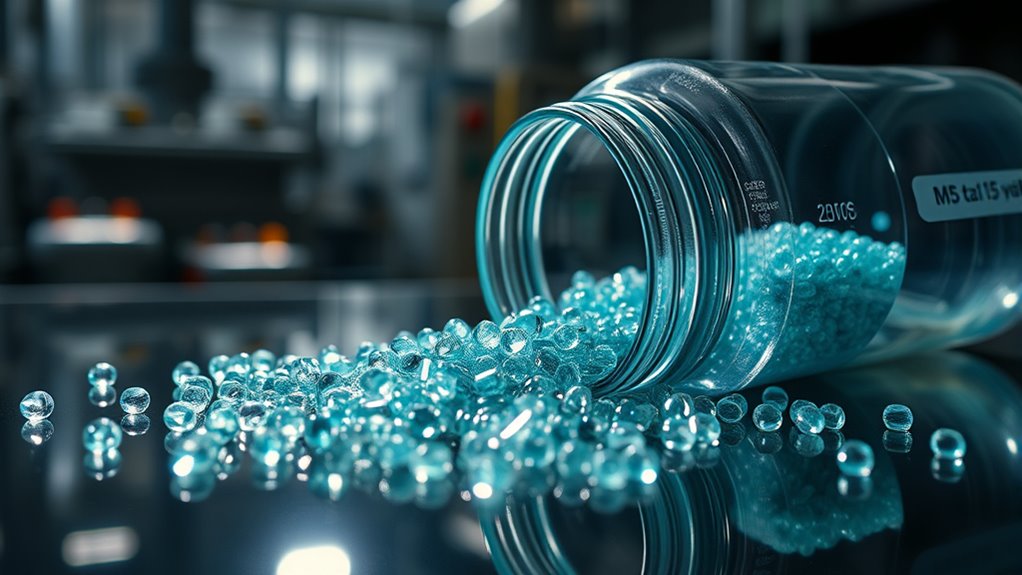Endocrine-disrupting chemicals (EDCs) in plastics can interfere with your hormonal systems, risking reproductive health, obesity, and developmental delays. These chemicals, like BPA and phthalates, can leach into your food and drinks, especially when plastics are heated or reused. Vulnerable groups such as pregnant women and children face higher risks. To protect yourself, learn how to minimize exposure and explore safer alternatives—more details can help you make informed choices to reduce your risks.
Key Takeaways
- EDCs in plastics mimic or block hormones, disrupting growth, reproduction, and metabolism, leading to long-term health risks.
- Common EDCs include BPA in polycarbonates and phthalates in PVC, which can leach into food and beverages.
- Higher temperatures and prolonged storage increase chemical migration from plastics into consumables.
- Vulnerable groups like pregnant women and children face higher risks of developmental and reproductive issues from EDC exposure.
- Regulatory efforts and consumer awareness are crucial to reducing contact with harmful endocrine-disrupting chemicals in plastics.
What Are Endocrine-Disrupting Chemicals and How Do They Function?
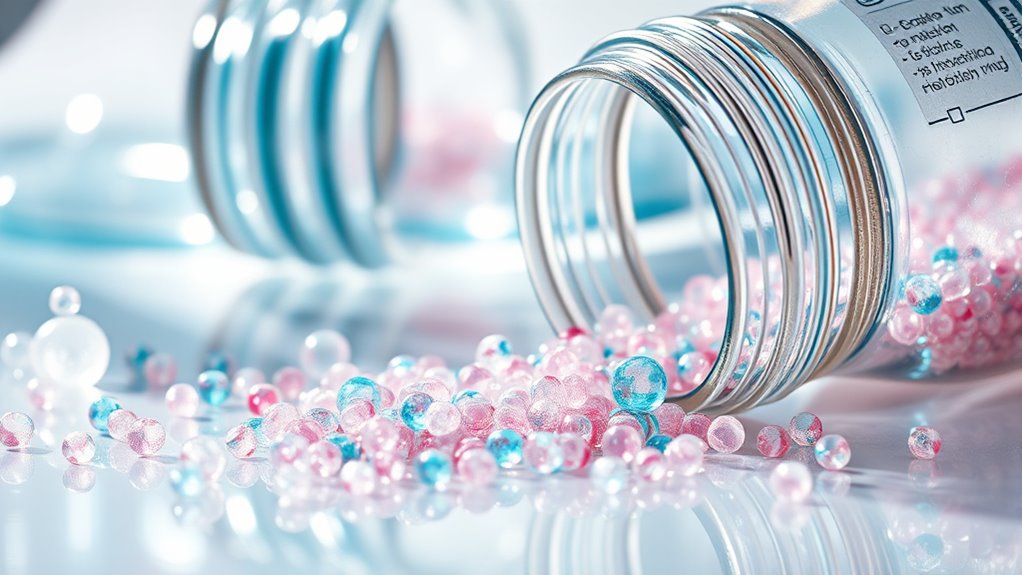
Endocrine-disrupting chemicals (EDCs) are substances that interfere with the body’s hormonal systems. They disrupt hormone function by mimicking natural hormones or blocking their actions, leading to hormone interference. One common way EDCs operate is through chemical mimicry, where these chemicals imitate hormones like estrogen or testosterone. When they enter your body, they bind to hormone receptors, tricking your cells into responding inappropriately. This can alter essential processes such as growth, reproduction, and metabolism. Because EDCs can persist in the environment and accumulate in your body, their effects may be long-lasting. Understanding how these chemicals function helps you recognize the potential risks associated with exposure, especially from everyday plastics and other sources. Additionally, vetted research confirms that certain plastics contain these harmful chemicals, emphasizing the importance of awareness and regulation. Recognizing chemical mimicry is crucial for understanding how these substances interfere with hormonal activity and cause health issues. Furthermore, the spiritual energy within and around us can influence how we respond to environmental toxins, highlighting the importance of maintaining energetic balance for overall well-being.
Common Plastics Containing EDCs and Their Sources

Many common plastics contain chemicals that can act as endocrine disruptors, posing risks to your health. These plastics often include chemical additives used during manufacturing or added later, which can leach into food or drinks. During plastic recycling, harmful substances may be concentrated or reintroduced, increasing exposure.
Be aware of plastics with these characteristics:
- Polyvinyl chloride (PVC): Contains phthalates as plasticizers, linked to hormone disruption.
- Polycarbonate (PC): Made with bisphenol A (BPA), a well-known EDC.
- Polystyrene (PS): Often contains styrene, which may interfere with hormonal functions.
Understanding these sources helps you minimize exposure to EDCs in everyday plastic products.
How EDCs Leach Into Food and Beverages

You might notice that certain plastics release chemicals into your food or drinks, especially when they contain specific types of polymers. Higher temperatures can increase the rate of leaching, making warm or hot foods more risky. Additionally, storing food for extended periods in plastic containers can lead to more chemicals seeping into your meals. Using safe, heat-resistant containers can reduce the risk of chemical transfer during food storage and heating. Incorporating energetic awareness when choosing containers can also help support overall health and well-being. Moreover, selecting containers made from biodegradable materials may further decrease potential chemical exposure associated with plastic leaching.
Plastic Types and Leaching
Certain types of plastics are more prone to releasing endocrine-disrupting chemicals (EDCs) into food and beverages they contain. Different plastics vary in their propensity for chemical migration, especially during use and disposal. For example, plastics like Polycarbonate and PVC are known for higher EDC content. When plastic recycling processes aren’t thorough, residual chemicals may remain, increasing leaching risks. Be aware that:
- Not all plastics are safe for food storage
- EDC release depends on plastic composition and age
- Chemical migration can increase with repeated use
Understanding plastic types helps you minimize EDC exposure. Choosing safer options and avoiding reused plastics with unclear recycling history reduces the likelihood of harmful chemical leaching into your food and drinks.
Temperature’s Impact on Release
Temperature plays a significant role in how much endocrine-disrupting chemicals (EDCs) can leach from plastics into food and beverages. When you expose plastics to higher temperatures, the chemical stability of the plastic decreases, making it easier for EDCs to migrate into your food. Heating plastic containers, especially those not designed for high temperatures, accelerates this release. Even during plastic recycling, heat can alter the material’s chemical structure, increasing the likelihood of EDC leaching. The higher the temperature, the greater the risk of these chemicals migrating into your consumables. To reduce exposure, avoid heating food in plastic containers, particularly those not labeled as heat-safe. Understanding this relationship helps you make safer choices when handling plastics in your daily life.
Food Storage Duration
The length of time plastic containers hold food or beverages directly influences how much endocrine-disrupting chemicals can leach into your items. Over extended storage durations, plastic aging accelerates, increasing chemical migration. The longer your food stays in plastic, the higher the risk of EDC exposure. Factors like repeated use, heat, and sunlight can worsen plastic aging, boosting leaching potential. Pay attention to:
- Extended storage durations that allow more chemicals to migrate
- Reusing single-use plastics, which worsens plastic aging
- Exposure to heat or sunlight, speeding up chemical leaching
- Plastic degradation over time further enhances chemical migration into food.
To minimize risks, avoid long-term storage in plastic containers, especially for hot or acidic foods. Replace old or scratched plastics regularly. Shorter storage durations help reduce EDC transfer into your food and beverages. Additionally, choosing plastic aging options for vehicle modifications can improve handling and safety, paralleling the importance of minimizing chemical exposure in daily life.
Health Risks Associated With EDC Exposure

Exposure to endocrine-disrupting chemicals (EDCs) in plastics can pose serious health risks, affecting your body’s hormonal balance and functioning. These synthetic chemicals can mimic or block natural hormones, leading to issues like reproductive problems, obesity, and developmental delays. The health implications are wide-ranging, impacting your endocrine system’s ability to regulate essential processes. Visualize this impact with the table below, illustrating common sources and effects:
| Source | Synthetic Chemicals | Health Implications |
|---|---|---|
| Plastic containers | BPA, phthalates | Reproductive issues, cancer |
| Food packaging | Flame retardants | Hormonal imbalance |
| Water bottles | Antimony, bisphenols | Metabolic disruptions |
These chemicals quietly disrupt your health, emphasizing the importance of awareness and precaution. Understanding the refrigeration cycle can enhance efforts to minimize environmental exposure to harmful substances, especially considering the role of chemical migration from plastics into food and water. Additionally, choosing eco-friendly materials for food storage can further reduce potential risks.
Vulnerable Populations and Susceptibility Factors
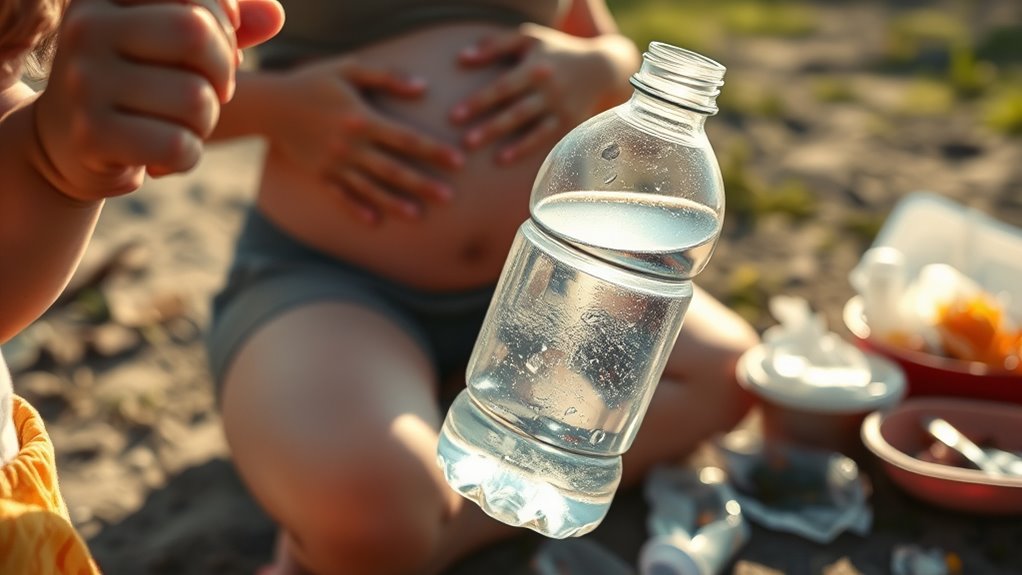
Certain groups are more vulnerable to the health effects of endocrine-disrupting chemicals found in plastics. Vulnerable populations include those with increased susceptibility factors that heighten their risk. These factors influence how your body processes and responds to EDC exposure. For example:
- Developing fetuses and infants, whose organs and hormonal systems are still forming.
- Pregnant women, who can transfer chemicals to their unborn children.
- Individuals with compromised immune or endocrine systems, making them more sensitive to chemical disruptions.
- The high sensitivity of certain populations underscores the importance of understanding the role of *color accuracy* and *contrast ratios* in evaluating environmental safety measures. Recognizing susceptibility factors can help in developing targeted interventions to protect vulnerable groups.
Understanding these susceptibility factors helps you recognize why some groups face greater health risks. It’s vital to take into account these vulnerabilities when evaluating the impacts of plastic-related EDC exposure, as they can influence the severity and long-term consequences of health effects.
Detecting and Measuring EDC Levels in the Body
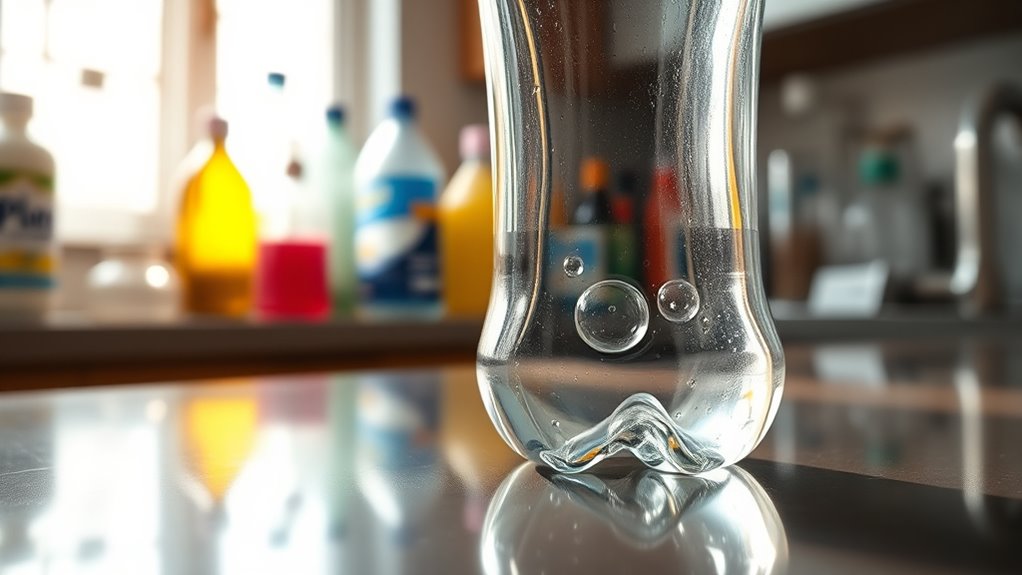
Detecting and measuring endocrine-disrupting chemicals (EDCs) in your body involves sophisticated analytical techniques that can identify even tiny amounts of these compounds. Biomonitoring techniques, such as blood, urine, and tissue analysis, help assess your exposure levels accurately. Analytical detection methods like mass spectrometry and chromatography enable precise identification and quantification of EDCs. Here’s a quick overview:
| Technique | Sample Type | Sensitivity Level |
|---|---|---|
| Biomonitoring | Blood, urine | Very high |
| Analytical detection | Tissue, fluids | Extremely sensitive |
| Quantitative analysis | Various samples | Accurate measurements |
| Data interpretation | All methods | Critical for assessment |
Additionally, advances in material analysis are continually improving the detection of EDCs, making it easier to monitor exposure and mitigate potential health risks. Incorporating advanced detection techniques can further enhance the accuracy of exposure assessments, leading to better-informed health decisions. Utilizing analytical sensitivity allows for detection of even trace levels of chemicals, which is essential for comprehensive health evaluations.
Strategies to Minimize Exposure to EDCs
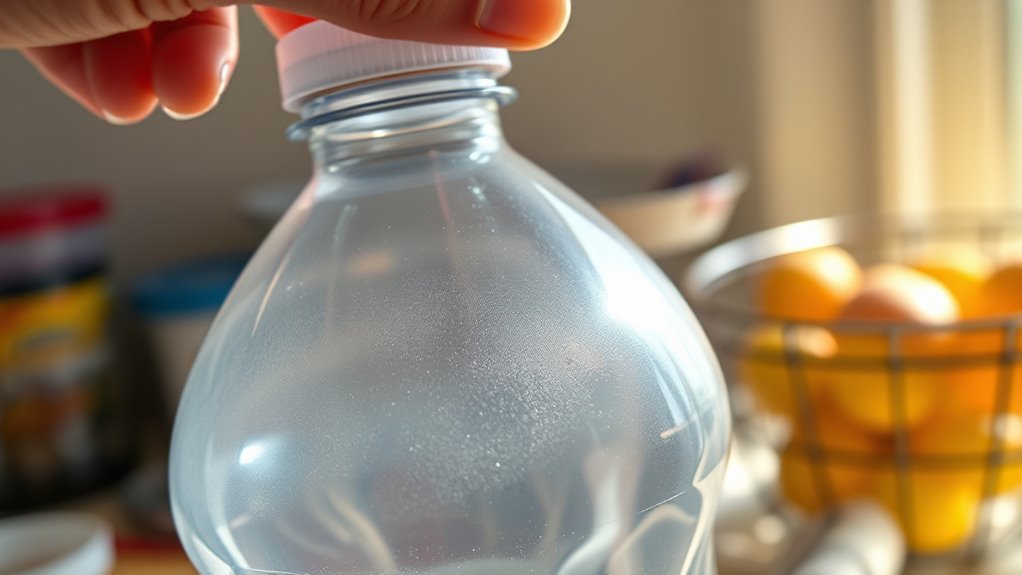
To reduce your exposure to endocrine-disrupting chemicals, start by choosing products labeled as EDC-free whenever possible. Properly dispose of plastics to prevent environmental contamination, and cut back on plastic use overall. These simple steps can substantially lower your risk of EDC exposure. Engaging in necessary cookies can also help you develop mindful habits and innovative solutions for managing environmental health challenges.
Choose EDC-Free Products
Choosing EDC-free products is one of the most effective ways to reduce your exposure to endocrine-disrupting chemicals. Opt for items labeled as free from BPA and phthalates, especially when buying plastics. Look for products made with eco-friendly packaging and biodegradable plastics, which are safer options for both your health and the environment. To make better choices, consider these tips:
- Select glass or stainless steel containers instead of plastic.
- Choose products with minimal or eco-friendly packaging.
- Support brands committed to avoiding harmful chemicals and using biodegradable plastics.
- Staying informed about practical support initiatives can help you find safer product options and reduce health risks associated with EDCs.
Proper Plastic Disposal
Proper plastic disposal is essential for reducing your exposure to endocrine-disrupting chemicals (EDCs). To do this effectively, follow recycling guidelines carefully to guarantee plastics are sorted correctly and processed safely. Proper plastic waste management minimizes the chance of plastics breaking down into microplastics that can leach EDCs into your environment. Avoid throwing plastics in regular trash if they can be recycled, and always clean containers before disposal. Check local recycling programs for specific guidelines, as not all plastics are recyclable everywhere. Proper disposal prevents plastics from ending up in landfills or the environment, where they can degrade and release harmful chemicals. By managing plastic waste responsibly, you reduce EDC exposure and contribute to a healthier environment.
Reduce Plastic Use
Reducing your plastic use directly lowers the amount of plastics that can break down and release endocrine-disrupting chemicals (EDCs) into your environment. By cutting back, you minimize exposure to these harmful substances. Boost your consumer awareness by choosing alternatives to plastic products and avoiding single-use items. Proper plastic recycling also helps reduce the need for new plastic production, which limits EDC release. To achieve this, consider:
- Using reusable bags, bottles, and containers
- Opting for products made from glass or stainless steel
- Supporting brands that prioritize eco-friendly packaging
These strategies not only lessen your plastic footprint but also help prevent the proliferation of EDCs in your environment. Small changes can make a significant difference in protecting your health and the planet.
Regulatory Measures and Industry Responses
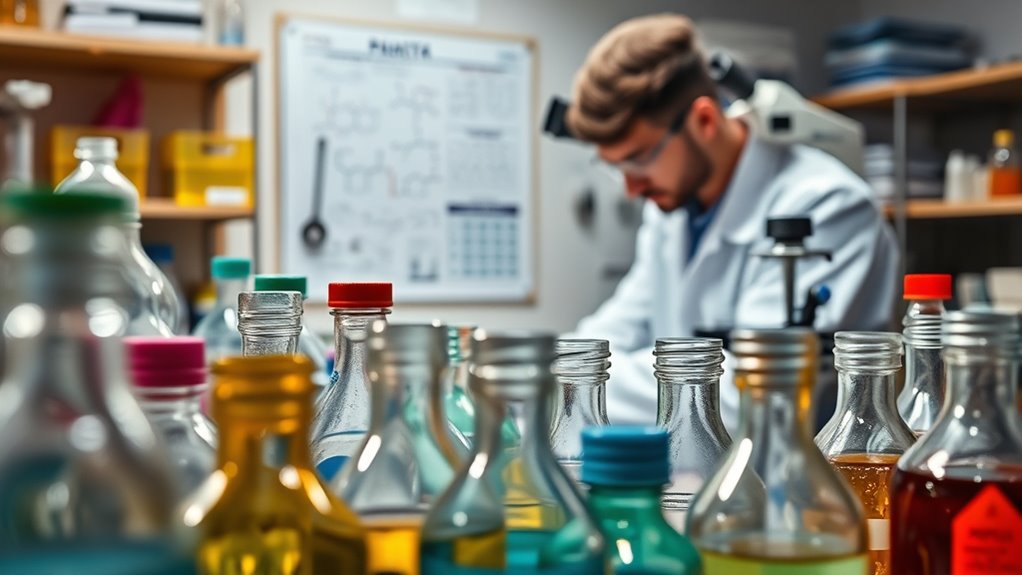
Regulatory measures have become increasingly strict as awareness about the health risks posed by endocrine-disrupting chemicals (EDCs) in plastics grows. Governments worldwide are implementing stricter regulatory policies to limit EDC exposure, such as banning certain chemicals in food packaging and consumer products. These policies aim to reduce health risks and promote safer alternatives. Industry initiatives also play a crucial role; many companies are voluntarily phasing out harmful chemicals, adopting safer materials, and improving transparency. Some corporations are investing in research to develop EDC-free plastics, responding proactively to consumer concerns. These combined efforts reflect a shift toward safer manufacturing practices and stricter regulation, helping to mitigate public health risks associated with endocrine disruptors in plastics.
Alternatives to Conventional Plastics With Reduced EDC Risks
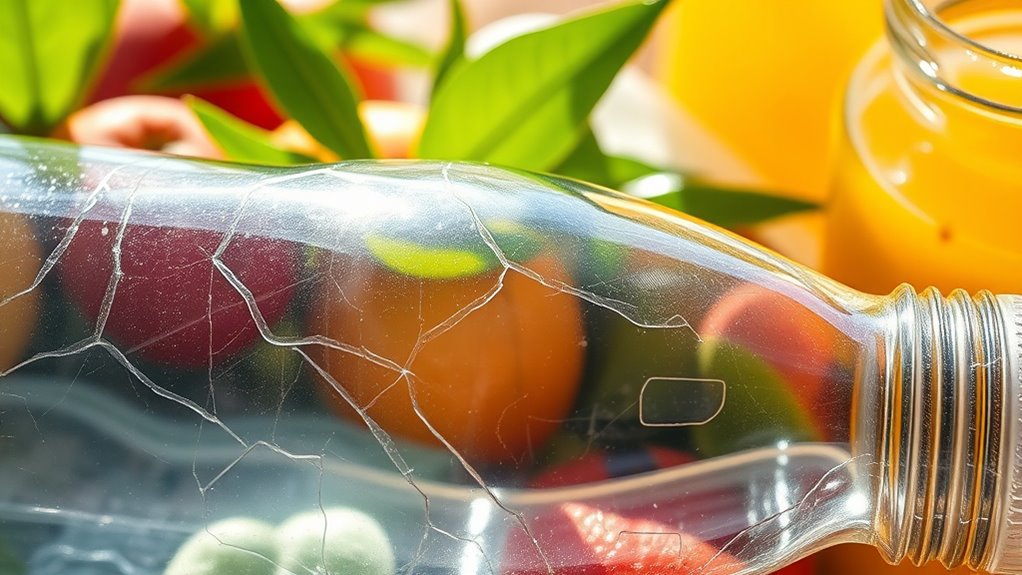
As industries and regulators push for safer manufacturing practices, researchers and manufacturers are exploring alternatives to conventional plastics that pose fewer endocrine-disrupting risks. You can consider options like biodegradable plastics and plant-based polymers, which offer more sustainable solutions. These alternatives reduce reliance on chemicals linked to endocrine disruption and degrade more quickly in the environment. Key benefits include:
- Biodegradable plastics that break down naturally, minimizing long-term pollution
- Plant-based polymers derived from renewable resources, lowering chemical exposure
- Innovative materials engineered to eliminate harmful additives in traditional plastics
Staying Informed and Protecting Your Health
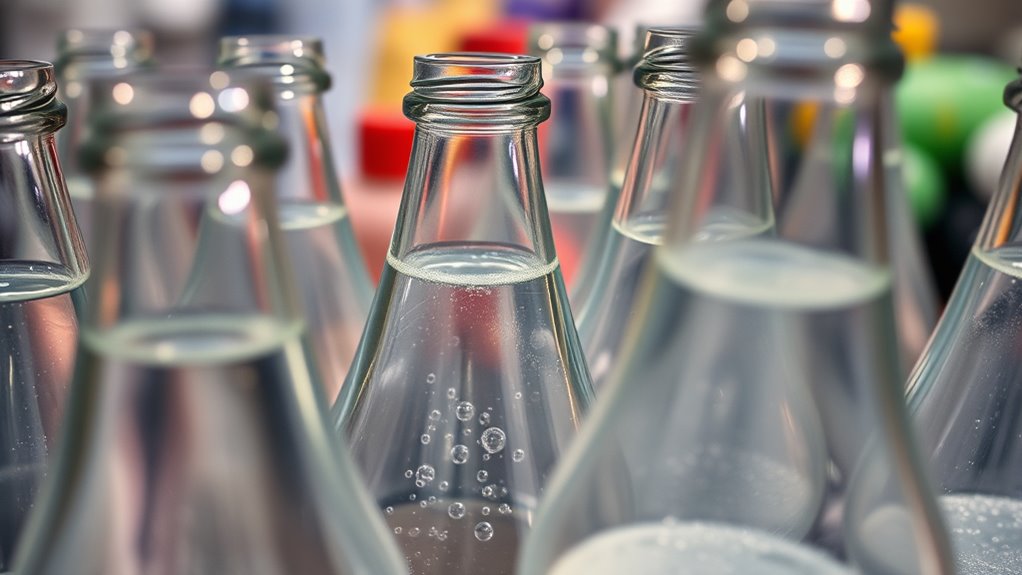
How can you stay informed and protect your health amid growing concerns about endocrine-disrupting chemicals in plastics? Start by researching reputable sources like government agencies and scientific studies that focus on chemical stability and environmental persistence. Avoid plastics labeled with recycling codes 3 and 7, which are more likely to contain harmful additives. Use alternatives like glass or stainless steel for food and beverages to minimize exposure. Keep up with updates on new regulations and safety guidelines. Be aware that some chemicals persist in the environment long after disposal, increasing exposure risks. By staying informed, you can make smarter choices to reduce your contact with endocrine disruptors and safeguard your health against the long-term effects of these persistent chemicals.
Frequently Asked Questions
Are There Natural or Biodegradable Plastics Free From EDCS?
You’re wondering if there are natural or biodegradable plastics free from endocrine-disrupting chemicals (EDCs). Yes, biodegradable plastics like polylactic acid (PLA) and natural plastic alternatives such as cellulose-based materials are designed to be eco-friendly and often contain fewer or no EDCs. These options break down more easily and reduce health risks associated with traditional plastics. Always verify product labels to ensure they’re free from harmful additives.
How Long Do EDCS Stay in the Human Body?
Think of EDCS like uninvited guests lingering in your body’s quiet corners. Their biological half-life varies, with some sticking around for days or weeks, while others may stay longer. Your body gradually eliminates these chemicals through bodily processes, but it’s a slow dance. Factors like age, health, and exposure influence how quickly they’re cleared. So, stay vigilant—your body’s elimination isn’t instant, and some EDCS may linger longer than you’d like.
Can Cooking or Heating Plastics Eliminate EDCS?
You might wonder if heating or cooking plastics can eliminate plastic leaching. Unfortunately, heating impacts plastics by increasing the risk of endocrine-disrupting chemicals leaching into your food or drinks. Higher temperatures can cause more EDCS to migrate from the plastic into your meal. So, instead of reducing the risk, heating often worsens plastic leaching. It’s best to avoid heating plastics altogether to minimize exposure to these harmful chemicals.
What Are the Long-Term Health Effects of Low-Level EDC Exposure?
Imagine small sparks causing a wildfire; that’s how low-level EDC exposure can impact you over time. You might not notice immediate effects, but chronic hormone disruption can subtly influence your health, affecting reproductive systems, metabolism, and mood. Developmental impacts are especially concerning if exposure occurs during critical growth periods. Long-term, these tiny doses may increase your risk of hormone-related diseases, emphasizing the importance of minimizing contact with endocrine disruptors.
Are There Any Government Programs to Reduce EDCS in Consumer Products?
You might wonder if government programs exist to reduce EDCS in consumer products. Yes, many countries have implemented regulatory policies to limit these chemicals and improve safety standards. Public awareness campaigns also play a vital role in educating consumers about EDCS risks. These efforts aim to encourage manufacturers to reduce or eliminate harmful substances, helping you make safer choices and protect your health over the long term.
Conclusion
To protect yourself from the hidden villains lurking in plastics, stay vigilant and informed. Think of EDCs as silent pirates sailing into your body, threatening your health. By choosing safer alternatives and advocating for stronger regulations, you hold the compass to steer clear of these toxic waters. Your awareness is the lighthouse guiding you safely through the storm, ensuring you and your loved ones stay healthy and resilient amid the plastic sea.
